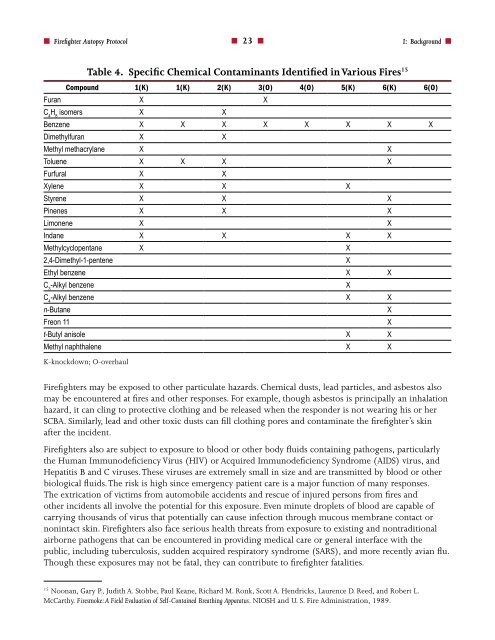Firefighter Autopsy Protocol - US Fire Administration - Federal ...
Firefighter Autopsy Protocol - US Fire Administration - Federal ...
Firefighter Autopsy Protocol - US Fire Administration - Federal ...
Create successful ePaper yourself
Turn your PDF publications into a flip-book with our unique Google optimized e-Paper software.
■ <strong><strong>Fire</strong>fighter</strong> <strong>Autopsy</strong> <strong>Protocol</strong><br />
■ 23 ■<br />
I: Background ■<br />
table 4. specific chemical contaminants identified in various <strong>Fire</strong>s 15<br />
Compound 1(K) 1(K) 2(K) 3(O) 4(O) 5(K) 6(K) 6(O)<br />
Furan X X<br />
C 4<br />
H 8<br />
isomers X X<br />
Benzene X X X X X X X X<br />
Dimethylfuran X X<br />
Methyl methacrylane X X<br />
Toluene X X X X<br />
Furfural X X<br />
Xylene X X X<br />
Styrene X X X<br />
Pinenes X X X<br />
Limonene X X<br />
Indane X X X X<br />
Methylcyclopentane X X<br />
2,4-Dimethyl-1-pentene<br />
X<br />
Ethyl benzene X X<br />
C 3<br />
-Alkyl benzene<br />
X<br />
C 4<br />
-Alkyl benzene X X<br />
n-Butane<br />
X<br />
Freon 11<br />
X<br />
t-Butyl anisole X X<br />
Methyl naphthalene X X<br />
K-knockdown; O-overhaul<br />
<strong><strong>Fire</strong>fighter</strong>s may be exposed to other particulate hazards. Chemical dusts, lead particles, and asbestos also<br />
may be encountered at fires and other responses. For example, though asbestos is principally an inhalation<br />
hazard, it can cling to protective clothing and be released when the responder is not wearing his or her<br />
SCBA. Similarly, lead and other toxic dusts can fill clothing pores and contaminate the firefighter’s skin<br />
after the incident.<br />
<strong><strong>Fire</strong>fighter</strong>s also are subject to exposure to blood or other body fluids containing pathogens, particularly<br />
the Human Immunodeficiency Virus (HIV) or Acquired Immunodeficiency Syndrome (AIDS) virus, and<br />
Hepatitis B and C viruses. These viruses are extremely small in size and are transmitted by blood or other<br />
biological fluids. The risk is high since emergency patient care is a major function of many responses.<br />
The extrication of victims from automobile accidents and rescue of injured persons from fires and<br />
other incidents all involve the potential for this exposure. Even minute droplets of blood are capable of<br />
carrying thousands of virus that potentially can cause infection through mucous membrane contact or<br />
nonintact skin. <strong><strong>Fire</strong>fighter</strong>s also face serious health threats from exposure to existing and nontraditional<br />
airborne pathogens that can be encountered in providing medical care or general interface with the<br />
public, including tuberculosis, sudden acquired respiratory syndrome (SARS), and more recently avian flu.<br />
Though these exposures may not be fatal, they can contribute to firefighter fatalities.<br />
15<br />
Noonan, Gary P., Judith A. Stobbe, Paul Keane, Richard M. Ronk, Scott A. Hendricks, Laurence D. Reed, and Robert L.<br />
McCarthy. <strong>Fire</strong>smoke: A Field Evaluation of Self-Contained Breathing Apparatus. NIOSH and U. S. <strong>Fire</strong> <strong>Administration</strong>, 1989.
















